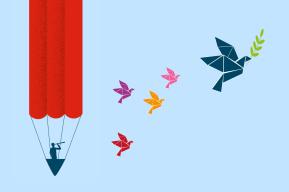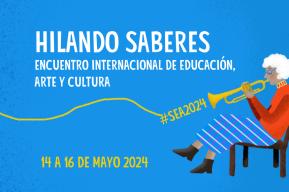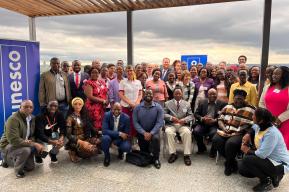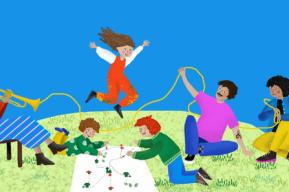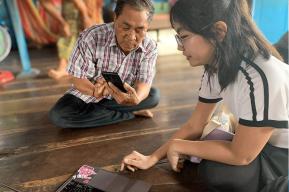News
Artists Patricia Domínguez (Chile) and Chloé Delarue (Switzerland) selected to take part in the second edition of the international residency program Simetría
For the second year running, Switzerland and Chile are joining to promote creativity in the arts, sciences, and astronomy with Simetría, an interdisciplinary exchange program between artists and scientists at the NRAO/ESO/NAOJ ALMA and Paranal observatories of the European Southern Observatory (ESO) in Chile, and CERN in Geneva, Switzerland, through efforts by institutions linked to these two groups.
In view of the global health situation, the residency will take place semi-remotely, with the artists starting their research from their habitual studios and homes, traveling to the scientific centers for three weeks in 2021, on a date to be determined based on mobility conditions.

With the goal of strengthening interdisciplinary exchange between artists and scientists who live or work in Chile and Switzerland, the Simetría program combines two artists at three of the world's top scientific research centers: CERN in Geneva, Switzerland, and two astronomy observatories in Chile: ALMA (Atacama Large Millimeter/submillimeter Array) in the highlands of San Pedro de Atacama and the Paranal Observatory, site of the Very Large Telescope (VLT).
The initiative is organized by Arts at CERN in Geneva (Switzerland), and the Corporación Chilena de Video y Artes Electrónicas (CChV) in Chile, with the support of ALMA, ESO, Pro Helvetia, the Executive Department of Visual Arts at the Chilean Ministry of Cultures, Heritage, and the Arts, and the representation in Chile of the United Nations Educational, Scientific and Cultural Organization (UNESCO). These bodies have all come together with the purpose of connecting artists with the international community of physicists and engineers to explore and investigate the challenges of contemporary science through advanced technologies that probe and observe nature and outer space.
It should be noted that, in view of the current health situation and to prevent the spread of coronavirus, the residency will take place semi-remotely, with the artists starting their research from their habitual studios and homes until conditions are suitable for them to travel to their residency locations for three weeks in 2021.
“Simetría is inspired by artistic exploration in the fields of astronomy, astrophysics, and cosmology, in dialogue with research into particle physics and the subatomic kingdoms of matter,” said Enrique Rivera, president of the Corporación Chilena de Video. “The joint residency by two artists at three of the most outstanding research centers in these fields will certainly help expand and explore new limits of artistic exploration," he added.
Meanwhile, Arts at CERN director and curator Mónica Bello noted: "Simetría makes a major contribution to facing the challenges of contemporary culture, and was designed as a program to promote interchange and dialogue between artists and scientists and researchers in the fields of particle physics and the cosmos sciences."
During its first iteration in 2019, the program invited Swiss artist Alan Bogana and Chilean artist Nicole L’Huillier to develop their research projects and works. The latter went on to be awarded the 2020 Harold and Arlene Schnitzer Prize in the Visual Arts, an annual award to students at the Massachusetts Institute of Technology (MIT).
Now in its second iteration, the program invited nine artists from each country to submit their portfolios, which were reviewed by an expert panel comprising: Arts at CERN director Mónica Bello; Chilean Ministry of Cultures, Heritage, and the Arts Photography Coordinator Ximena Moreno; digital curator and artist Marco de Mutiis; and Enrique Rivera, president of the Corporación Chilena de Video. The panel finally resolved to invite Chilean artist Patricia Domínguez and Swiss artist Chloé Delarue to take part in the residency program.
“This residency is an important opportunity to put elements of my work up against complex fields of research, linked to fundamental experimentation and observation,” said Swiss artist Chloé Delarue, adding: "The rare possibility of meeting, getting to know, and observing people whose research centers on the observation and analysis of such abstract things that also form the physical building blocks of our universe will allow me to access a visual and oral vision that questions different levels of the objectivity of reality."
Meanwhile, Chilean artist Patricia Domínguez commented: “My artistic investigation has focussed on the multi-species relations that we establish in the 21st century, between humans, animals, plants, and the elementals of the earth, like the fires in the Bolivian Amazon or the water crisis in Chile. Being a part of Simetría will expand those relations in a fractal way, expanding them to the cosmos and turning them towards the fundamental particles that make us up.”
"We are very happy to be a part of this action, and we look forward to the processes that artists Patricia Dominguez and Chloé Delarue are set to begin shortly, which we hope will highlight interesting intersections between astronomy and particle physics," said Minister Consuelo Valdés, who added that "Chile's Ministry of Cultures, Heritage, and the Arts strives to promote the development of the arts, reflection, and research – areas that enhance our country’s culture and knowledge.”
María Angélica Vial, the regional coordinator of the Coincidencia Swiss-South American cultural exchange program for the Pro Helvetia Foundation, commented: "Simetría uses the arts to bring together three of the world's most significant scientific centers. This kind of exchange program, particularly during the current times, is an act of resistance; we believe that it is ever more necessary to connect art and science and to promote fluid interchange between these disciplines, which at the end of the day examine essential questions. We are very happy to be able to support this project once again.”
Nicolás del Valle, Associate Coordinator of the UNESCO Santiago Culture Programme, noted: "Simetría is an unprecedented international cultural cooperation initiative, bringing together artists from different countries and linking the arts with high-level scientific centers to reflect on relations between the arts, technology, and society. UNESCO's interest centers on promoting creative solutions for a sustainable future for culture and the sciences."
Indeed, the European Southern Observatory (ESO) representative in Chile, Claudio Melo, stated: “We are very happy for the VLT and ALMA to be part of this initiative once again, as the arts and the sciences elevate the spirit and remind us of the importance of treasuring the dimension of creativity, curiosity, and discovery, which in a sense defines us as humans, and so much never be forgotten.”
The two artists are to take part in a seminar in December, held at the 5th Digital Culture, Science, and Art Congress, a biennial event that brings together a diverse group of people active in culture, science, and the arts to open conversations about the social, cultural, and scientific transformations facing Chile. There, the artists will discuss their research alongside Chilean and international scientists and astronomers.
About the artists
Patricia Domínguez (Chile, 1984)
Drawing together ethnobotany, curating practices, and the corporatization of wellbeing in her experimental research, Patricia Domínguez' work centers on tracing relationships of work, affection, obligation, and emancipation among living species in an increasingly corporate cosmos.
Her studies include a Master’s degree in Studio Art from Hunter College, New York (2013), and a Certificate in Botanical Illustration and Natural Sciences from the New York Botanical Garden NYBG (2011). She is currently the director of the ethnobotanical platform Studio Vegetalista.
Her principal projects have been exhibited at centerscenters such as CentroCentro (Madrid), Gasworks (London), Momenta Biennale (Canada), Pizzuti Museum (Ohio), Seoul Museum of Art SeMA (Seoul), and El Futuro no es lo que va a pasar, si no lo que Vamos a hacer, ARCO, and Twin Gallery (all in Madrid). Museo del Barrio, Bronx Museum, The Clemente, Yeh Art Gallery (all in New York), FLORA (Colombia), and Meet Factory (Prague).
She has recently been awarded the Fundación AMA Grant (2017), the Fundación Telefónica Media Art Award (2014), and the Norberto Griffa Third Prize (2014). Her work has appeared in books such as Younger than Jesus: Artist Directory (2009) and Documents for Contemporary Art Issue HEALTH, published by the MIT Press and WhiteChapel (2020).
Her work is soon to be exhibited at the Museo Thyssen-Bornemisza (Madrid) and 37th Kassel Documentary and Film Festival 2020, Gwangju Biennale (South Korea), Transmediale (Berlin), La Casa Encendida (Madrid) 2021, and The Wellcome Collection (London) 2022.
Chloé Delarue (Suiza, 1986)
Chloé Delarue produces what she calls 'environments' under the TAFAA acronym for Toward A Fully Automated Appearance. Thus, TAFAA constitutes a conceptual organ or cognitive consequence that provides access to the reasoning that feeds into her work. It is under this name, indexed with a number or subtitle that she has presented each occurrence of her work since 2015.
After a first MAMA degree in 2012 from Ecole Nationale Supérieure d’Art – Villa Arson in Nice, she continued her studies at HEAD-Genève in the Fine Arts Master in 2014.
Her work has recently been shown at a number of individual exhibitions at sites such as Villa du Parc - art center, Annemasse (fr), 2020; the Museum of Fine Arts of Chaux-de-Fonds (ch), 2019; Salle de Bains, Lyon (fr), 2019, Kunsthaus Langenthal (ch), 2019; Urgent Paradise, Lausanne (ch), 2017; Sonnenstube de Lugano (ch), 2017, Palais de l'Athénée, Geneva (ch), 2016, and Nevers as part of the Parc Saint Léger - Hors les murs (fr), 2016.
She has also been featured in a number of collective exhibitions, such as Confort Mental, Paris (fr), 2019; Kunst(Zeug)Haus, Rapperswil-Jona (ch), 2019; Museum of Art of Pully (ch), 2019; Display, Berlin (de), 2018; Swiss Art Awards, Basel (ch), 2018; MAC Créteil (fr), 2018; HeK (Haus der Elektronischen Kunste), Basel (ch), 2018; Post Territory Ujeongguk, Seoul (kr), 2017; CAN Neuchâtel (ch), 2017; l’Istituto Svizzero, Roma (it), 2016; Rotwand Gallery, Zurich, 2016; Centre PasquArt, Bienne (ch), 2015, and Fri Art, Fribourg (ch), 2015 - 2013.
Chloé Delarue has been awarded the Abraham Hermanjat Grant (2018), the Hirzel Prize of the Société des Arts (2016), the Kiefer Hablitzel Award (2016), and the Lissignol-Chevalier and Galland Grant (2015).
Additional information
CCHV, the Corporación Chilena de Video y Artes Electrónicas, has been conducting research projects, productions, and exhibitions based on the relationship between art and science since 1993. Its initiatives include organizing the Chile Media Arts Biennial and the Space Art residency program, comprising a series of activities in which artists and astronomers work together to produce media artworks, documentaries, and other cultural and educational productions dedicated to strengthening understanding of the astronomical sciences in Chile.
ALMA, the Atacama Large Millimeter/submillimeter Array, is the world’s most powerful radio telescope, located at an elevation of 5,000 meters in the Andes mountains near San Pedro de Atacama. ALMA is a partnership of ESO (in representation of its member states), NSF (USA), and NINS (Japan), working together with NRC (Canada), MOST, and ASIAA (Taiwan), and KASI (South Korea), in cooperation with the Republic of Chile.
ESO, the European Southern Observatory, is Europe's principal inter-governmental astronomical organization and the world's most productive observatory. It has sixteen member states: Germany, Austria, Belgium, Denmark, Spain, Finland, France, Ireland, Italy, the Netherlands, Poland, Portugal, the United Kingdom, the Czech Republic, Sweden, and Switzerland, together with Chile, the host country, and Australia as a strategically. ESO undertakes an ambitious program centered on designing, building, and operating powerful ground-based observation installations that allow astronomers to make significant scientific discoveries. The body also plays a significant role in promoting and organizing cooperation in astronomical research. ESO operates three unique observation facilities in Chile: La Silla, Paranal, and Chajnantor. At Paranal, the ESO operates the Very Large Telescope and VLTI (Very Large Telescope Interferometer), the most advanced in the world, as well as two survey telescopes: VISTA (Visible and Infrared Survey Telescope for Astronomy), working in the infrared band, and VST (VLT Survey Telescope), used for visible light surveys. ESO is also a partner in two installations at Chajnantor, APEX, and ALMA, which is the world's largest operational astronomical project. Finally, on the Cerro Armazones mountain near Paranal, ESO is building the 39-meter ELT (Extremely Large Telescope), which will become "the world's largest eye for looking at the sky."
CERN, the European Organization for Nuclear Research, is the world's largest laboratory engaged in researching the fundamental principles of matter. It houses the Large Hadron Collider (LHC) and a complex of accelerators and detectors that allow research into the principles and laws that govern the fundamental structure of the universe. Established in 2011 and directed by Mónica Bello, Arts at CERN is the laboratory's art program, promoting interchange and dialogue between artists and physicists through residencies, new productions, and exhibitions on art and fundamental science.
Pro Helvetia is the Swiss Culture Foundation, which within the framework of COINCIDENCIA – Swiss-South American Cultural Exchange (2017-2020) promotes cultural exchanges between Swiss and South American arts professionals, creating new partnerships and facilitating the presence of Swiss artists in South American platforms, with the goal of strengthening critical artistic thinking through the circulation of people and content, exchange of tools between artists, and forging links between autonomous initiatives, curators, festivals, and institutions.
The Executive Department of Visual Arts is a division at the Ministry of Cultures, Heritage, and the Arts that works to strengthen and develop the visual arts sector; one of its main areas of action relates to bolstering a domestic and international working agenda with different agents and organizations in the field. It has also developed a significant agenda of actions relating to the crossover between art, science, and digital culture.
The United Nations Educational, Scientific, and Cultural Organization (UNESCO) seeks to promote peace through international cooperation in education, science, and culture. UNESCO programs promote the achievement of the Sustainable Development Goals specified in the 2030 Programme, which was passed by the United Nations General Assembly in 2015. UNESCO’s representation in Chile is based at the Regional Bureau of Education for Latin America and the Caribbean (OREALC/UNESCO Santiago), which also serves as the body’s official headquarters in the country.



